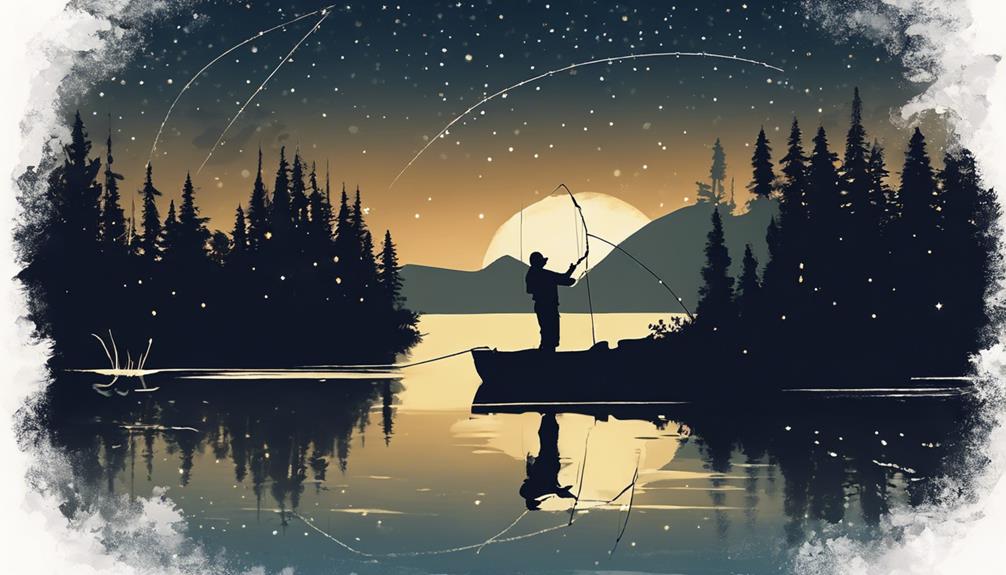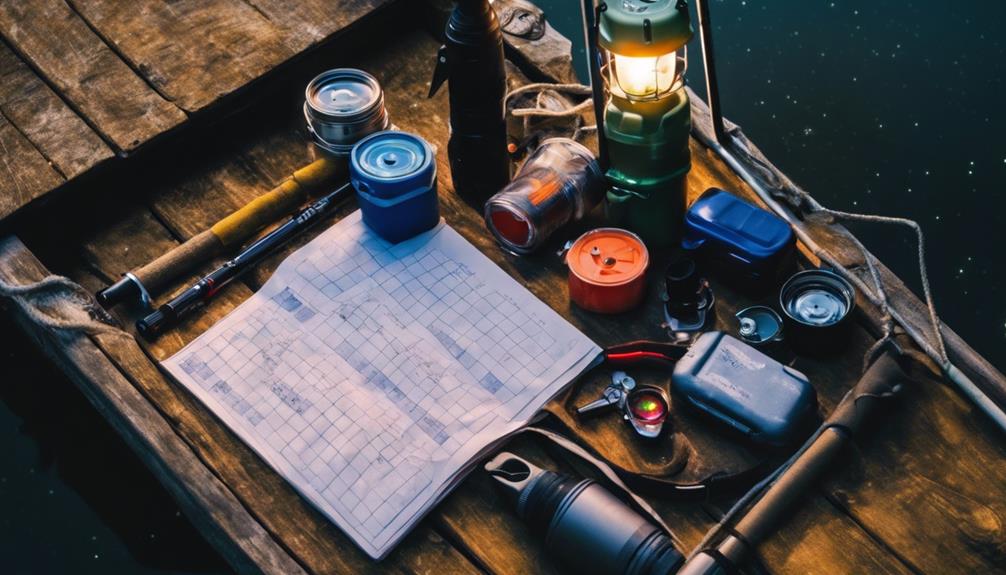To succeed in freshwater night fishing, focus on understanding fish behavior. Target areas where fish feed at night and align your strategy with their natural habits. Equip yourself with a waterproof flashlight and bite indicator for better navigation and fishing success. Opt for baits that produce vibrations or noise to attract fish effectively. Lastly, remember to prioritize safety by utilizing proper lighting and emergency supplies. By mastering these key tips, you can enhance your angling experience and increase your chances of landing that prized catch. Explore further to uncover additional insights for maximizing your freshwater night fishing endeavors.
Benefits of Night Fishing
Night fishing offers anglers a unique opportunity to target nocturnal species and escape the daytime crowds, providing a peaceful and productive fishing experience. The advantages of night fishing are numerous and cater to those seeking a different angling experience. One major benefit is the decreased competition from other anglers. With most anglers preferring to fish during the day, the night presents an ideal time to fish without the hustle and bustle of crowded fishing spots. Additionally, many fish species are more active at night, meaning anglers have a higher chance of catching fish during these hours.
Understanding the habits of nocturnal fish is crucial for successful night fishing. Many fish species are more active at night because they feel safer under the cover of darkness. Nocturnal fish such as catfish, walleye, and crappie tend to feed more actively during the night hours. These species have adapted to low light conditions and have developed heightened senses to detect prey in the dark. Anglers can take advantage of this behavior by using lures and baits that appeal to the heightened senses of these nocturnal species. By understanding and leveraging these habits, anglers can increase their chances of a successful night fishing expedition.
Understanding Fish Behavior at Night
To understand how fish behavior changes during nighttime hours, consider the natural adaptations and instincts that drive nocturnal species to become more active in low light conditions. Fish have evolved specialized sensory systems to navigate and hunt effectively in the dark. Nocturnal fish often rely more heavily on their sense of smell and lateral line system, which detects vibrations in the water, to locate prey. These sensory adaptations allow them to compensate for the reduced visibility at night.
Fish feeding behavior also shifts during nighttime. Many species of freshwater fish, such as catfish and bass, are known to be more active feeders after the sun sets. This is because they've a higher chance of securing a meal when other fish are less alert and more vulnerable. Additionally, the cover of darkness provides predatory fish with an advantage, as their prey may have a harder time detecting them approaching.
Understanding these nocturnal habits is crucial for successful night fishing. Anglers should target areas where fish are likely to feed during the night, such as near structures where prey seek shelter or in shallow waters where nocturnal insects gather. By aligning your fishing strategy with the natural behavior of fish at night, you can increase your chances of a successful freshwater night fishing experience.
Essential Gear for Night Fishing
When engaging in freshwater night fishing, it's essential to equip yourself with specialized gear tailored for low-light conditions. Two key pieces of gear that are crucial for a successful night fishing experience are a waterproof flashlight and a bite indicator.
A waterproof flashlight is a fundamental tool for night fishing. This type of flashlight is designed to withstand exposure to water, making it ideal for use during fishing activities where splashing or rain is common. A waterproof flashlight will help you navigate in the dark, locate your gear, handle your catch, and ensure your safety while fishing at night. Look for a flashlight with a bright beam and durable construction to withstand the rigors of fishing.
Another important gear item for night fishing is a bite indicator. Bite indicators are devices that provide visual or audible cues when a fish is showing interest in your bait. In low-light conditions, it can be challenging to detect subtle bites or movements on your line. A bite indicator helps you notice when a fish is interacting with your bait, increasing your chances of hooking a catch. Choose a reliable and sensitive bite indicator that's suitable for the type of fishing you're doing to enhance your night fishing success.
Choosing the Right Bait and Lures
Choosing the appropriate bait and lures plays a critical role in freshwater night fishing success. When it comes to night fishing tactics, selecting the right bait can significantly increase your chances of a successful fishing trip. One of the key considerations for night fishing is choosing baits that produce vibration or noise to attract fish in low light conditions.
For night fishing, lures that create movement and sound are highly effective. Topwater lures like buzzbaits or poppers can mimic the sound of prey moving on the water's surface, making them attractive to predatory fish. Additionally, lures equipped with rattles or spinners can help fish locate your bait in the dark.
When selecting bait for night fishing, consider using live bait such as nightcrawlers, minnows, or insects. These baits have natural scents and movements that can lure fish in the dark. Artificial baits like soft plastics or scented lures can also be successful at night, as they often have added attractants that appeal to fish's senses in low light conditions.
Safety Precautions for Night Fishing
For enhanced safety during night fishing excursions, it's crucial to implement proper lighting measures and carry essential emergency supplies. Night vision plays a vital role in ensuring you can navigate the waters safely and observe your surroundings effectively. Utilizing headlamps or LED lights with red or green filters can help preserve your night vision while providing sufficient illumination for tasks like baiting hooks or moving around the fishing area without disturbing the natural environment.
Emergency preparedness is another critical aspect of night fishing safety. Always carry a well-stocked first aid kit that includes supplies for treating common injuries like cuts, scrapes, or hook punctures. Additionally, having a fully charged cell phone or a two-way radio can be invaluable in case of emergencies. Make sure to inform someone trustworthy about your fishing plans, including your location and expected return time, for added safety.
When fishing at night, it's essential to be aware of potential hazards both in and out of the water. Check the weather forecast before heading out and be prepared for changing conditions. Keep an eye out for slippery rocks or uneven terrain around the fishing spot. By staying vigilant and following these safety precautions, you can enjoy a successful and secure night fishing experience.
Best Techniques for Freshwater Night Fishing
To optimize your success in freshwater night fishing, employing strategic bait presentation techniques is crucial. When engaging in moonlight fishing, consider using underwater lights to attract baitfish, thereby drawing in larger predatory fish. These lights create an enticing environment for fish, increasing your chances of a successful catch.
Additionally, utilizing night vision technology can greatly enhance your fishing experience. Night vision goggles or scopes allow you to see clearly in the dark, helping you spot fish and navigate your surroundings with ease.
A stealth approach is key when fishing at night. Fish are more sensitive to disturbances in low-light conditions, so it's essential to minimize noise and movement. Make sure to move quietly and avoid shining bright lights directly into the water, as this can spook fish. When casting your line, do so gently to prevent splashing that could startle nearby fish. By being stealthy and mindful of your actions, you increase your chances of attracting and hooking fish successfully.
Location Selection for Successful Night Fishing

When selecting a location for successful night fishing, consider the depth of the water and the proximity to underwater structures. The depth of the water is crucial as different fish species have specific depth preferences. Predatory fish tend to hunt in shallower waters, while others may be found in deeper areas. Proximity to underwater structures like rocks, fallen trees, or underwater vegetation is essential as these provide shelter for fish and attract prey species, leading to a higher concentration of fish in those areas.
Moon phases play a significant role in night fishing success. During a full moon, visibility is higher, which can make fish more cautious. Conversely, during a new moon, visibility is lower, making fish more active and less wary. Understanding the moon phases can help you adjust your fishing strategy accordingly.
Weather conditions also impact night fishing. Fish are sensitive to changes in barometric pressure, with many becoming more active before a storm. Wind can create ripples on the water's surface, breaking up light and making it harder for fish to see, thus encouraging them to come closer to the shore to feed.
Tips for Maximizing Your Night Fishing Experience
Maximize your night fishing experience by strategically adjusting your bait presentation to target different fish species based on their feeding behaviors. To enhance your success, consider the impact of weather conditions and moon phases on fish activity.
Weather conditions play a crucial role in night fishing. Warm, stable weather often leads to increased feeding activity among freshwater fish species. During such conditions, you may find success using topwater lures or noisy baits that create vibrations to attract fish in the low light environment. In contrast, when cold fronts approach, fish tend to become less active. In these situations, switching to slower presentations like soft plastic baits or jigs may yield better results.
Moon phases also influence fish behavior during night fishing expeditions. Fish are generally more active during full and new moon phases, when the moon is either directly above or below the Earth. This increased activity can result in better feeding behavior and heightened aggression among certain fish species. Conversely, during quarter moons when the moon is at its first or last quarter, fish activity may decrease. Adjust your fishing techniques accordingly by using brighter lures or baits during peak moon phases to attract fish more effectively.
Frequently Asked Questions
How Can I Prevent Insects From Bothering Me While Night Fishing?
To prevent insects from bothering you while night fishing, use insect repellent and proper lighting.
Insects are attracted to light, so opting for red or green lights can help reduce their presence.
Additionally, avoid using noisy equipment as this can disturb fish behavior and attract more insects.
What Type of Music or Sounds Can Attract More Fish at Night?
To attract more fish at night, consider the impact of underwater acoustics on fish behavior. Ambient sounds can influence fish activity levels. Using lure tactics in conjunction with specific sounds may increase your chances of catching fish during nighttime fishing sessions.
Experiment with different types of music or sounds to see which ones are most effective in attracting fish in freshwater environments. Understanding the role of sound in fishing can enhance your fishing experience.
Is It Safe to Fish Alone at Night in Remote Locations?
When fishing alone at night in remote locations, you must prioritize safety precautions and wilderness survival strategies. Remember to inform someone of your location and expected return time.
Carry essential gear like a flashlight, first aid kit, and navigation tools. Be aware of your surroundings, potential hazards, and wildlife encounters.
Proper preparation, situational awareness, and adherence to safety protocols are crucial for a successful and secure fishing experience in isolated areas.
Can Using a Headlamp Scare Away Fish While Night Fishing?
Using a headlamp as a light source while night fishing can indeed affect fish behavior. The bright light may startle fish, causing them to scatter or become wary. This can impact your fishing success negatively.
To avoid scaring away fish, consider using a red or green light for better night vision, as these colors are less likely to spook fish. Adapting your light source can help improve your chances of successful nighttime fishing.
How Do Moon Phases Affect Fish Activity During Night Fishing?
During night fishing, the lunar cycle influences fish behavior through moon phases. Fish tend to be more active during the full moon phase due to increased light levels, making it easier for them to hunt.
Conversely, during new moon phases with minimal light, fish may exhibit more caution and feed less. Understanding these lunar patterns can help you strategize your night fishing trips for optimal success in catching fish.
Conclusion
In conclusion, successful freshwater night fishing requires a combination of understanding fish behavior, using the right gear and bait, practicing safety precautions, and employing effective fishing techniques.
By following these key tips and maximizing your night fishing experience, you can increase your chances of catching more fish and enjoying a rewarding night on the water.
Remember to always be prepared, stay alert, and adapt to changing conditions for a successful night fishing excursion.



